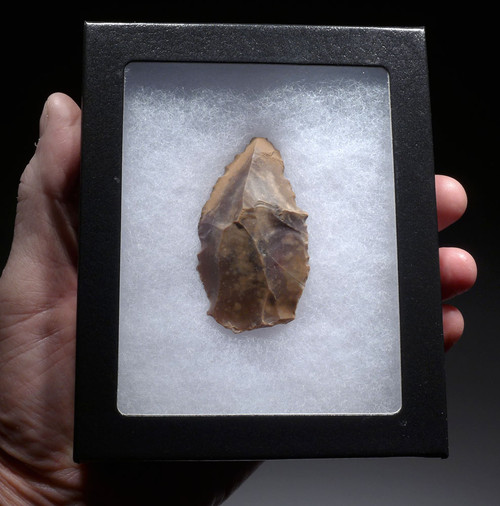Product Description
This is a masterfully executed Mousterian in the Acheulean Tradition (MAT) hand axe of the finest possible quality and condition. Made from basalt, it still retains its extremely sharp cutting edges and ORIGINAL THIN SHARP UNBROKEN TIP! Known from Europe, hand axes of the MOUSTERIAN IN ACHEULIAN TRADITION (MTA or MAT), show traits of the earlier Acheulian Period such as a faceted palm grip on the proximal end, and more primitive flaking techniques, but in reduced size that matches the typical size of other Mousterian examples found in North Africa. It is one of the BEST AFRICAN MOUSTERIAN hand axe we have offered and would be difficult to improve upon. The HIGHLY REFINED shape, extremely thin, sharp and unbroken tip, and secondary flaking is classic for this hand axe type.
The workmanship is truly spectacular and the original thin chopping end is still EXACTLY AS MADE IN ORIGINAL UNDAMAGED CONDITION. The form and execution of this extraordinary hand axe must be held to be appreciated. A bulb of stone was left for the right hand index finger to better grip the hand axe when in use. This axe possesses natural desert bi-color patina and sediment still embedded in micro-crevices - traits of an authentic Paleolithic Saharan artifact caused by long-term exposure on one side as it lay undisturbed, exposed for millennia.
SEE MORE MOUSTERIAN MIDDLE PALEOLITHIC TOOLS
HISTORY
This Middle Paleolithic stone tool was fashioned in the Mousterian tradition and could have been used by Neanderthals and Homo sapiens between approximately 300,000 and 30,000 years ago. It was collected from an exposed Mousterian site in the Sahara Desert of North Africa. The tool tradition of the Neanderthals is called the Mousterian Tradition. The Mousterian Tool Culture is found in one of the longest and most spectacular sequences in the whole of North Africa. Several open and cave sites are documented. Oddly, the North African Mousterian technology appears as fully developed unlike the gradual formative stages found in Europe. Neanderthal genome mapping has shown that numerous regions across North Africa had evidence of Neanderthal human populations whereas, Sub-Saharan Africa was devoid of Neanderthals.
 US DOLLAR
US DOLLAR
 EURO
EURO
 AUSTRALIAN DOLLAR
AUSTRALIAN DOLLAR
 CANADIAN DOLLAR
CANADIAN DOLLAR
 POUND STERLING
POUND STERLING


























